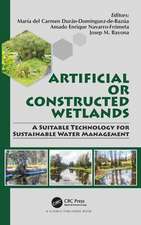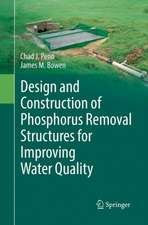Sustainable Water and Soil Management
Editat de Sabine Kunst, Tanja Kruse, Andrea Burmesteren Limba Engleză Paperback – 10 apr 2012
Preț: 646.30 lei
Preț vechi: 760.35 lei
-15% Nou
Puncte Express: 969
Preț estimativ în valută:
123.68€ • 134.30$ • 103.89£
123.68€ • 134.30$ • 103.89£
Carte tipărită la comandă
Livrare economică 22 aprilie-06 mai
Preluare comenzi: 021 569.72.76
Specificații
ISBN-13: 9783642639616
ISBN-10: 3642639615
Pagini: 416
Ilustrații: XVI, 416 p.
Dimensiuni: 155 x 235 x 22 mm
Greutate: 0.58 kg
Ediția:Softcover reprint of the original 1st ed. 2002
Editura: Springer Berlin, Heidelberg
Colecția Springer
Locul publicării:Berlin, Heidelberg, Germany
ISBN-10: 3642639615
Pagini: 416
Ilustrații: XVI, 416 p.
Dimensiuni: 155 x 235 x 22 mm
Greutate: 0.58 kg
Ediția:Softcover reprint of the original 1st ed. 2002
Editura: Springer Berlin, Heidelberg
Colecția Springer
Locul publicării:Berlin, Heidelberg, Germany
Public țintă
ResearchCuprins
Gendersensitive, Participatory Approach of Water and Soil Management.- 1 The International Women’s University — Framework for the Project Area Water.- 1.1 The Future of Higher Education (Aims).- 1.2 The International Women’s University and Intercultural Science.- 1.3 Junior Women Scientists.- 1.3.1 Selection Process in the Project Area Water.- 1.3.2 Profile of the Junior Scientists in the Project Area Water.- 1.3.3 Catering to Participants’ Needs: Service Centre.- 1.4 ifu as a Platform for Global Dialogue.- 2 ifu — an Intercultural Innovation in Higher Education ?.- 2.1 The Intercultural ifu.- 2.1.1 Internationalisation or Parochialisation?.- 2.1.2 The Socio-Political Context.- 2.1.3 The Feminist Agenda.- 2.1.4 Culture as Social Practice.- 2.1.5 The Many Differences.- 2.1.6 Intercultural Training at ifu.- 2.1.7 The Interculturality of Knowledge Production.- 2.2 Conclusion.- References.- 3 The Project Area Water.- 3.1 Water is Life — Background Information.- 3.2 Feminist Perspectives at the Action Level.- 3.3 The Concept of the Project Area Water.- 3.4 Curriculum of the Project Area Water.- 3.4.1 Knowledge Transfer.- 3.4.2 Practical Projects.- References.- Aspects of Water and Soil Management.- 4 Rural Development with Special Emphasis on Women, Water and Environment.- 4.1 An Experiment in the Creation of Knowledge, Skills and Attitude.- 4.2 Feminisation of Water Management — an Indian Concept.- 4.2.1 India — the Land and People.- 4.2.2 Rural Women’s Participation in Water Management in Maharashtra State.- 4.2.3 An Alternative Vision Planned and Directed by Rural Women.- 4.3 An Interdisciplinary and International Approach to Rural Development within ifu.- 4.3.1 Women and Rural Development.- 4.3.2 Rural Women — Water and the Environment.- 4.3.3 Skill Development.- 4.3.4 Exposure to Different Realities, Field Trips and Excursions.- 4.4 The ifu Experiment as a Beginning of a New Endeavour.- References.- 5 Water Treatment and Rainwater Harvesting.- 5.1 Overview.- 5.2 Water Disinfection Methods.- 5.2.1 Physical and Chemical Methods.- 5.2.2 Biological Method.- 5.2.3 Bacterial Contamination.- 5.3 Rainwater Harvesting — Two Scenarios.- 5.4 Description of the Project.- 5.4.1 Presentation of Excursions.- 5.4.2 Results.- 5.5 Rainwater Harvesting Project Plan Developed by the Women Junior Scientists.- 5.5.1 Rainwater Harvesting for Household Consumption (Philippines by Angelica R. Martinez).- 5.5.2 Case Study on Rainwater Harvesting (Albania by Gentiana Haxhillazi).- 5.5.3 Rainwater Harvesting — A Proposal for Secondary Schools (Tanzania by Eng. Immaculata Nshange Raphael).- 5.5.4 Rainwater Harvesting (USA by Margaret Fredricks).- 5.5.5 Promotion of Rainwater Harvesting in the Arid Area (Cameroon by Michele Denise Akamba Ava, Maroua Salak).- 5.5.6 Rainwater Harvesting Draft Plan for a Vegetable Garden (India by Nandini Sankarampadi, Sanjulata Prasad).- Rainwater Harvesting Plan for Loyola College (Nigeria by Theresa Odejayi, Yetunde Odeyemi, Helen Oloyede).- 5.6 Summary.- References.- 6 Wastewater Treatment.- 6.1 Mechanical Wastewater Treatment.- 6.1.1 Overview.- 6.1.2 Rakes and Strainers.- 6.1.3 Sand Catchers.- 6.1.4 Preliminary Treatment/Settling Tank.- 6.2 Biological Wastewater Treatment.- 6.2.1 Overview.- 6.2.2 Legal Requirements for Wastewater Treatment in Europe.- 6.3 Models for the Design and Simulation of WastewaterTreatment Plants (WWTPs).- 6.3.1 Overview.- 6.3.2 Dynamic Models.- 6.3.3 Use of Computer Programs.- 6.4 Evaluation of Centralised Wastewater Treatment.- 6.4.1 Comparison of Wastewater Treatment Plants.- 6.4.2 Conclusions.- References.- 7 Decentralised Wastewater Treatment — Wastewater Treatment in Rural Areas.- 7.1 Situation.- 7.1.1 Principles and Spheres of Action.- 7.1.2 Decentralisation and User Participation.- 7.2 Nature-Based Wastewater and Sludge Treatment Methods as Components of Sustainable Concepts in Rural Regions — State of the Art.- 7.2.1 Introduction.- 7.2.2 Overview — Wastewater Quantities and Wastewater Agents in Rural Areas.- 7.2.3 Pre-Treatment.- 7.2.4 Planted Soil Filters.- 7.2.5 Wastewater Lagoons.- 7.2.6 Sludge Composting in Reed Beds.- 7.2.7 Practical Examples.- 7.3 Conclusions for Design Parameters.- 7.3.1 Characteristics of Decentralised Wastewater Treatment Systems which are Conducive to Sustainable Development.- 7.3.2 Impact of Gender Perspectives on Planning Criteria.- 7.4 Examples of Planning Ideas.- 7.4.1 Wastewater Purification for Remote Villages.- 7.4.2 Planning Ideas for Sensitive Regions in Rural Areas.- References.- 8 Alternative Technologies for Sanitation, Recycling and Reuse.- 8.1 Overview.- 8.2 The Composting Process.- 8.2.1 The Phases.- 8.2.2 Environmental Factors in Composting.- 8.2.3 Composting Micro-Organisms.- 8.2.4 Quality Criteria for Compost as a Product.- 8.3 Types of Toilets.- 8.3.1 Water Toilets.- 8.3.2 Waterless Toilets.- 8.4 Composting Toilet Systems.- 8.4.1 Dimensioning Composting Toilets.- 8.4.2 Dry Sanitation with Reuse.- 8.4.3 Dehydration Toilets.- 8.4.4 Decomposition Toilets.- 8.4.5 Types of Composting Toilet Systems.- 8.5 SIRDO.- 8.5.1 Pathogens Elimination.- 8.5.2 Social Evaluation.- References.- 9 River Development Planning.- 9.1 River Protection for the Balance of Nature.- 9.2 Hydraulics and River Protection.- 9.2.1 Some River Characteristics.- 9.2.2 River Discharge.- 9.2.3 The River Protection System of Lower Saxony/Germany.- 9.2.4 Making an Inventory in Situ.- 9.3 Stahlbach River Development Plan.- 9.3.1 The Elbe Catchment Area.- 9.3.2 The Stahlbach River.- 9.3.3 River Stahlbach Development Project (Project Modules).- 9.3.4 Results.- 9.4 Summary.- References.- 10 Water and Soil Towards Sustainable Land Use.- 10.1 Overview.- 10.1.1 Soils.- 10.1.2 Soil and Water.- 10.1.3 Global Significance.- 10.2 Project Water and Soil.- 10.2.1 Skills and Aims.- 10.2.2 Stahlbach Creek Project.- 10.2.3 Methodology.- 10.3 Results of The Project.- 10.3.1 Case Study: River Elbe Ecology Project.- 10.3.2 Description and Results of the Three Project Sites.- 10.4 Summary.- 10.4.1 Intergroup Interferences.- References.- Conclusions.- 11 Evaluation “There is No Unanimous Judgement on ifu”.- 11.1 Evaluation Concept.- 11.2 Bridging the Gap Between Mutually Unfamiliar Disciplines and Socio-Technical Innovation.- 11.2.1 Curriculum of the Project Area Water.- 11.2.2 Evaluation of the Curriculum from the Perspective of the Junior Scientists.- 11.2.3 From the Perspective of the Visiting Scholars: “You Can Feel It in the Air”.- 11.2.4 Description of the Study Venue — the Environment from the Perspective of the Junior scientists.- 11.3 Incongruity of the Perspectives: A Summary.- References.- 12 Future Perspectives for Sustainable Water and Soil Management.- 12.1 Internationally and Intercultural Work.- 12.2 Interdisciplinary Work and Gender Perspectives.- 12.3 Women’s International Network for Sustainability: A Post-ifu Initiative Promoting Equitable and Ecologically Sound Alternatives to Mainstream Development.- 12.3.1 “Development is Well-Being — Concerning the Individual as well as the Community Level — for the Past, Present and Future.” (Andrea Heckert, U.S. Mexico).- 12.3.2 “What Should I Say? Now We Are Developed?” (Christobel Chakwana, Malawi).- 12.3.3 “...I Would Like to Have a Computer, this Would Empower Me.” (Arig Bakhiet, Sudan).- References.- Appendices.- 13 Manual for Analysis of Soils and Related Materials.- 13.1 Introduction to Soil Exploration and Soil Sampling.- 13.2 Moisture Content and Dry Weight.- 13.3 Determination of Organic Matter.- 13.4 Determination of pH.- 13.5 Salinity of Soils (Electric Conductivity, EC).- 13.6 Cress Test (Germinability of Lepidium sativum).- 13.7 Determination of Total Amount of Micro-organisms in Solids (Microbial Number).- 13.8 Soil Respiration, Biological Oxygen Demand (BOD).- 13.9 Respiration Activity of Compost.- 13.10 Carbon Content.- 13.11 Determination of Nitrogen (Kjeldahl Procedure).- 13.12 C/N and C/P Ratio.- 13.13 Determination of Carbonate.- 13.14 Determination of Plant-Available Phosphorus and Potassium.- 13.15 Determination of Plant-Available Potassium and Magnesium (diluted with Calcium Chloride).- 13.16 Determination of N — min (NO3 and NO2).- 13.17 Determination of N-min (NH4).- 13.18 Determining Exchangeable Cations at Soil pH.- 13.19 Nitrohydrochloric Acid Disintegration.- 13.20 Sewage Sludge Regulations.- 13.21 Elution with Water.- 13.22 Soil Moisture Retention Capacity, pF Value.- 13.23 Soil Texture (Grain Size Distribution) 3.- 13.24 Grain Fractions and Texture Types.- References.- 14 Influencing BOD and N Removal Assessment of Important Parameters.- 14.1 Batch Tests as a Method for Classifying Nitrification and Denitrification Activities in Activated Sludge.- 14.1.1 Batch Tests for Nitrification (Aerobic).- 14.1.2 Batch Tests for Denitrification (Anoxic).- 14.2 Respirometry: Determination of the Oxygen Uptake Rate (OUR).- 14.2.1 Determination of the Respiration Rate of Activated Sludge by Measuring the O2 Utilisation Rate.- 14.2.2 Evaluation of the Recorded Data.- 14.2.3 Dependence of Oxygen Consumption on Toxic or Inhibiting Substances in Water.- 14.2.4 Further Applications for Oxygen-Consumption Measurements.- Vitae of Contributors.
Caracteristici
Water and soil management towards sustainable use with emphasis on aspects and gender equality
Suitable for academics, engineers and those working in projects of foreign aid in the countries of Asia and Africa
Suitable for academics, engineers and those working in projects of foreign aid in the countries of Asia and Africa









